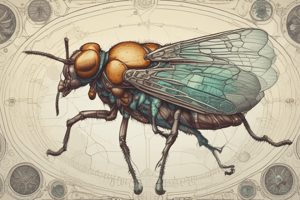Podcast
Questions and Answers
What is unique about the proboscis of the tsetse fly?
What is unique about the proboscis of the tsetse fly?
- It is rigid and forward-projecting (correct)
- It is flexible and backward-projecting
- It is short and blunt
- It is long and curved
What is a characteristic of the sheep ked (Melophagus ovinus)?
What is a characteristic of the sheep ked (Melophagus ovinus)?
- It has a narrow head and lays eggs
- It has a rounded head and incomplete metamerphosis
- It has six legs and is a temporary parasite
- It has a blunt head and three main body parts (correct)
What is a result of severe infestations of sheep keds?
What is a result of severe infestations of sheep keds?
- Increased appetite and aggression
- Weight loss and anaemia (correct)
- Weight gain and improved wool quality
- Improved skin health and increased energy
What is unique about the wings of the tsetse fly at rest?
What is unique about the wings of the tsetse fly at rest?
What is a characteristic of fleas?
What is a characteristic of fleas?
Which of the following is NOT a characteristic of lice?
Which of the following is NOT a characteristic of lice?
What is the characteristic of the female hard ticks?
What is the characteristic of the female hard ticks?
Which of the following ticks transmit blood protozoa?
Which of the following ticks transmit blood protozoa?
What is the characteristic of the soft ticks?
What is the characteristic of the soft ticks?
Which of the following mites causes intense itching and dry skin?
Which of the following mites causes intense itching and dry skin?
What is the diagnostic method for Sarcoptes scabiei?
What is the diagnostic method for Sarcoptes scabiei?
What is the characteristic of the adult mites?
What is the characteristic of the adult mites?
What is a distinctive feature of deer flies?
What is a distinctive feature of deer flies?
What is a key difference between stable flies and house flies?
What is a key difference between stable flies and house flies?
What disease is transmitted by black flies?
What disease is transmitted by black flies?
What is a characteristic of blowflies?
What is a characteristic of blowflies?
What is a common behavior of sand flies?
What is a common behavior of sand flies?
What is a physical characteristic of horse flies?
What is a physical characteristic of horse flies?
Flashcards are hidden until you start studying
Study Notes
Lice
- Suborder Anoplura (sucking lice): Linognathus sp. infests dogs, with a narrower head than thorax and incomplete metamorphosis
- Suborder Mallophaga (chewing lice): Antennae stick out from head, blunt heads wider than thorax; Trichodectes canis infests dogs and sheep keds (Melophagus ovinus)
Fleas
- Ctenocephalides felis (cat flea) and Ctenocephalides canis (dog flea): wingless, laterally compressed with powerful hind legs and piercing-sucking mouthparts; temporary obligate parasites, feeding on blood as adults and causing anemia; intermediate host for Dipylidium caninum
Flies
Tsetse fly
- 31 species and subspecies, all belong to genus Glossina; yellowish or brown-black, robust flies (6-14 mm long) with rigid forward-projecting proboscis and a closed cell (hatchet cell) between wing veins 4 and 5; wings rest over abdomen like closed scissors
Tabanus (Horse fly)
- Transmits sand fly fever and leishmaniasis; Tabanid flies; large, biting flies (up to 2.5 cm) with big eyes; deer flies (Chrysops) have distinct bands on their wings
Bot Fly
- Infests sheep, also known as Sheep Bot Flies
Ticks
Soft Ticks (Argasidae)
- Infest birds; body covered in leathery soft skin; both males and females engorge when feeding on blood; capitulum situated on ventral side of body near anterior end; veterinary importance in genus Ornithodoros (large animals) and Argas (birds)
Hard Ticks (Ixodidae)
- Oval in shape, pointed at the front; females engorge, while males have scutum covering the whole dorsal side; transmit blood protozoa like Babesia, Theileria, Anaplasma, and cause tick paralysis and anemia; examples include Amblyomma spp., Rhipicephalus spp., and Hyalomma spp.
Mites
- Adult mites have eight legs; distinguished from ticks by absence of teeth from hypostome of mouthparts and setae on body and legs; Sarcoptes scabiei (mange mite) causes intense itching, dry and thickened skin that becomes crusty; diagnosis: deep skin scraping at periphery of lesions; Demodex spp. also exist
Studying That Suits You
Use AI to generate personalized quizzes and flashcards to suit your learning preferences.




